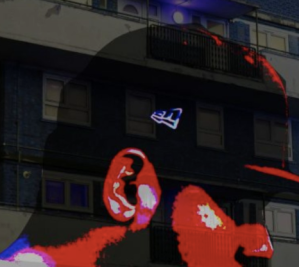I was fortunate enough to shadow the hip hop theatre company Beats & Elements during part of their rehearsal process for the play High Rise Estate of Mind, which ran at the Battersea Arts Centre from 20th-29th March 2019. It will show at Camden People’s Theatre from 7-11th May 2019. This series of ‘Notes from the Rehearsal Room’ documents some of the thoughts and ideas stimulated by the rehearsal process, and by our chats and discussions in the breaks.
*
I think rage is my favourite emotion, despite its bad reputation. There is something thrilling about the clarity of it — its power. I like how it appears suddenly, like the tarry, turquoise sheen on the surface of crude oil; its liability to catch the light and cast a rainbow.
The scholar Tiffany Watt Smith, in her beautiful compendium, The Book of Human Emotions, writes that rage is increasingly unacceptable in contemporary culture, particularly in Britain and America where expressing rage is often equated with succumbing to explosive and irrational anger. She points to political theorist Hannah Arendt’s work (On Violence) to suggest that rage is, in fact, not irrational at all, but most often a response to conditions of injustice that could be changed, but are not. ‘Only when our sense of justice is offended’, writes Arendt, ‘do we act with rage.’
In many ways, High Rise Estate of Mind is borne of rage — not only because it explores conditions of contemporary injustice in London’s housing market, but because of the qualities it embodies in its presentation. The language of rage runs through the piece, evident in both the carefully crafted metaphors that create the fictional world, and in the performers’ ‘real world’ stories of their own housing experiences. The confrontational nature of the performance, with the cast standing stark, a few feet away from the audience, on a mostly bare stage (transparent plastic chairs, coloured shafts of light and musical equipment the only scenographic interventions), delivering lines that outline the brutality of capitalism, feels angry, but necessarily so.
The performance also draws on a semiotics of urban rage, often denigrated and misunderstood in the popular press and cultural commentary. They wear black hooded tracksuits, with red armbands and baseball caps — a nod to the so-called street culture associated with council estates, gangs and urban poverty, challenging what it means to be on the edges of society by weaving complex poetry, dressed in the uniform of the reviled other. Their musical influences, in hip hop and grime, draw on a tradition of cultural politics that is often mistaken for mindless violence. So too their choreographed movements are sharp and often aggressive: jabs and punches that spar with the audience, transmitting how it feels to be bound in a social and economic strata that often leaves you fighting for your very existence.
In rehearsals there is no sense of aggression, but anger does simmer under the surface of our conversations. We reflect on how injustice can produce rage, reminiscing about our relationships to the riots that broke out across London in 2011. The riots were a response to the killing of Mark Duggan by police — but were also symptomatic of a (then recently implemented) culture of austerity, in which any sense of a social safety net was stripped away by cuts to welfare benefits and local provision of services. We all sympathise with the rioters — portrayed as irrational, feral criminals by politicians and the tabloid press — and discuss how our initial emotional reaction to the riots was a sense of solidarity in rage: we wanted to (but didn’t) join the rioters in demonstrating our violent opposition to the actions of the state.
Conrad Murray and Paul Cree, who make up the company Beats & Elements (and who are half the cast of High Rise), have described the aesthetic of their previous projects as ‘council estate rage’. A statement that suggests the way class, space and the wider inequalities of our social system can produce particular tenors of emotion. In my book, Social Housing in Performance, I trace the ways this particular iteration of working-class anger has been misunderstood, arguing that council estate rage articulates an ‘insider perspective’. A perspective ‘where [the] presentation of what might seem “anti-social” by middle-class moral standards is revealed as a glass-shield that barely conceals the core of discontentment, fear and pain that often characterizes the working-class lived experience’. In High Rise, the company channel this council estate rage aesthetic again, creating a work that is transparent, yet uncomfortable at moments, and difficult to digest.
Being in the rehearsal room reminded me of the complexity of rage and its potency. People who have ready access the so-called negative range of emotions — anger, bitterness, spite, jealousy — are the people I want to be around. Not because I find that relentless wallowing in negativity is enjoyable — but because of what ready access to the full human emotional spectrum can create. There is political potential in those less pleasant emotions, but there’s something else too. We often think that rage is closest to hate in the order of things; that indulging rage breeds intolerance and misery. I don’t find that to be true. Expressing rage — articulating just rage through art, and violence when necessary — is the only way to survive injustice and remain intact. Rage is not only hatred — it is wit and precision and the sharp end of the arrow that might pierce something vital. Rage is necessary for joy.

